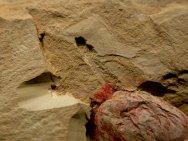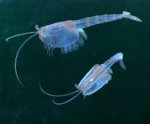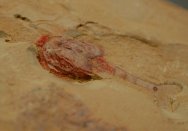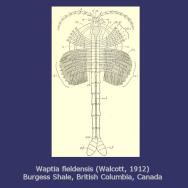Chuandianella ovata
Formerly Waptia Ovata
Phylum Arthropoda (Clade Crustaceanomorpha), Extinct Order Waptiida, Family Waptiidae
Geological Time: Early Cambrian (~525 million years ago)
Size: The chuandianella fossil is some 18 mm long (plus antennae), with a shell 10 mm long by 8 mm across
Fossil Site: Changjiang Maotianshan Shales (Chengjiang Biota), Quiongzhusi Section, Yu’anshan Member, Heilinpu Formation, Mafang Village , Anning, Kunming, Yunnan Province, China
|
The
systematic position of this taxon has undergone several revisions.
It was originally placed within the Ostracodiform genus Mononotella,
then later referred to a new genus Chaundianella. More recent
finds
of remains other than the carapace have shown it to be similar
to the Burgess Shale arthropod
Waptia fieldensis. However, Chuandianella has notably different
features, including classic arthropod biramous limbs. While
the species is known from other Discovered in 1984, the Chengjiang Biota now ranks as the most diverse faunal fossil assemblage of all the Burgess Shale like deposits. It is also some 10 million years older than the Burgess Shale, and like the Burgess Shale, non-mineralized soft tissue parts are often extraordinarily well preserved with high resolution as aluminosilicate films, sometimes with oxidized iron content. Various taphonomic processes leading extensive preservation of soft tissue have been proposed, including rapid death by asphyxia followed by rapid burial in anoxic sediment undisturbed by turbidity. The Chengjiang biota is dominated by the phyla Arthropoda and Porifera. There are seven lobopodians, more than any other Lagerstätte that some scientists elevate to phylum rank, and seven members of the extinct phylum Vetulicolia. Members or potential members of phyla Priapulida, Nematomorpha, Hyolitha, Hemichordata, Echinodermata, Ctenophora, Chordata, Cnidaria, Chaetognatha, and Brachiopoda are found. A large number of enigmatic animals of uncertain affinity are found as well, some of which may represent failed evolutionary experiments, or even new phyla that did not persist for long in the early to middle Cambrian, or were rapidly replaced by more derived forms. Among the diverse Maotianshan Shales fauna, of utmost important are the putative early chordates, particularly Haikouella, potentially an ancestor to or the earliest craniate chordate. Myllokunmingia and Haikouichthys are interpreted as early Craniata, and possibly very primitive agnathids, the progenitor of the fishes and all vertebrates. References:
Also
see: Chengjiang Maotianshan Shales, Chengjiang
Biota, Chengjiang
Fossils, Cambrian
Explosion |








